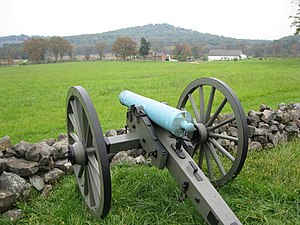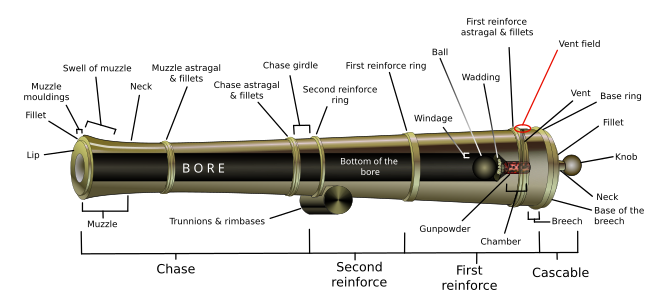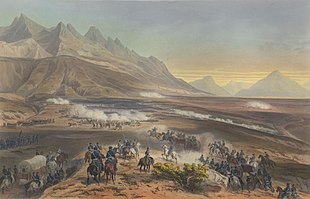M1841 12-pounder howitzer
| M1841 12-pounder Field Howitzer | |
|---|---|
 M1841 12-pounder field howitzer is seen at Gettysburg National Military Park looking toward Big Round Top. | |
| Type | Howitzer |
| Place of origin | United States |
| Service history | |
| In service | 1841–1868 |
| Used by | United States |
| Wars | Mexican–American War American Civil War |
| Production history | |
| Manufacturer | Cyrus Alger & Co. N. P. Ames Eagle Foundry, Cincinnati William D. Marshall & Co. |
| Produced | 1841 |
| No. built | over 251 |
| Variants | 1835 (26), 1838 (24), Confederate (118 bronze and 96 cast iron) |
| Specifications | |
| Mass | 785 lb (356.1 kg) |
| Length | 53.0 in (1.35 m) |
| Crew | 9 |
| Shell weight | 8.9 lb (4.0 kg) shell 1.0 lb (0.5 kg) charge |
| Caliber | 4.62 in (117 mm) |
| Barrels | 1 |
| Action | Muzzle loading |
| Carriage | 900 lb (408.2 kg) |
| Effective firing range | 1,072 yd (980 m) |
The M1841 12-pounder field howitzer was a bronze smoothbore muzzle-loading artillery piece that was adopted by the
For the related M1841 12-pounder mountain howitzer, see this article.
Background
At the beginning of the 19th century, armies employed field guns for direct artillery fire and mortars for high-angle fire. Intermediate between the field gun and mortar was the howitzer which launched an explosive shell on a curved trajectory against enemy personnel or fortifications. In general, a howitzer required a smaller charge than a field gun to lob a projectile of similar weight. Larger howitzers were often named after the size of the bore (or caliber), for example the 8-inch howitzer.[1] On the other hand, by British and American convention, some howitzers were named after the field gun which had the same bore size.[2] Therefore, in the US Army, the weapon was named the 12-pounder howitzer because it had the same bore size as the 12-pounder gun, which was 4.62 in (117 mm) in diameter. Since a smaller charge was needed to fire a projectile, the 12-pounder howitzer had a smaller chamber near the breech 3.67 in (93 mm) in diameter.[1]
Manufacture of bronze artillery pieces required
Cyrus Alger & Co. delivered 19 and N. P. Ames delivered 7 bronze Model 1835 12-pounder howitzers in 1837–38. The two companies produced 24 more bronze Model 1838 12-pounder howitzers in 1839–40. The Model 1835 was 53.0 in (1.35 m) in length and weighed 717 lb (325.2 kg) while the Model 1838 was 49.0 in (1.24 m) in length and weighed 690 lb (313.0 kg). During the period 1834–1841, Alger, Ames, the West Point Foundry, and the Columbia Foundry produced small numbers of cast iron versions, but no large contracts resulted.[4]
The final bronze Model 1841 12-pounder howitzers manufactured by Alger and Ames served the US Army for the next 27 years (i.e until 1868). The Model 1841 was 53.0 in (1.35 m) long and weighed 785 lb (356.1 kg). At least 251 Model 1841 12-pounder howitzers were produced by Alger, Ames, and other companies.[5] Ames and Alger each delivered their first 6 Model 1841 howitzers in October and November 1841.[6] The Eagle Foundry of Miles Greenwood in Cincinnati, Ohio produced 14 bronze M1841 12-pounder howitzers for the U.S. Army in 1861–62. The Western Foundry of William D. Marshall & Co. of St. Louis, Missouri delivered 16 bronze M1841 12-pounder howitzers to the U.S. Army during the same period.[7]
Several foundries in the Confederacy manufactured an estimated 118 bronze and 66 cast iron 12-pounder howitzers during the American Civil War. Leading all producers was the Tredegar Iron Works which delivered 42 bronze and 30 cast iron 12-pounder howitzers. Other Confederate producers of this weapon were Quinby and Robinson (43), T. M. Brennan (26), Noble Brothers (14), Leeds (9), John Clark (7), Washington Foundry (7), Wolff (3), A. B. Reading (2), and Skates (1).[8] The Confederate-made iron 12-pounder howitzer was several inches longer than the U.S. version and weighed 850 lb (385.6 kg).[9]
Note that the
| Description | No. Accepted | Base ring diameter | Length w/o knob | Bore length | Bore len. calibers | Weight of barrel |
|---|---|---|---|---|---|---|
| Model 1835 | 26 | 9.8 in (24.9 cm) | 53.0 in (134.6 cm) | 43.25 in (109.9 cm) | 9.36 | 717 lb (325.2 kg) |
| Model 1838 | 24 | 9.8 in (24.9 cm) | 49.0 in (124.5 cm) | 39.25 in (99.7 cm) | 8.5 | 690 lb (313.0 kg) |
| Model 1841 | 251+ | 10.0 in (25.4 cm) | 53.0 in (134.6 cm) | 43.25 in (109.9 cm) | 9.36 | 785 lb (356.1 kg) |
Specifications

The Model 1841 bronze 12-pounder howitzer barrel was 53.0 in (134.6 cm) from the base ring to the muzzle and weighed 785 lb (356 kg). The diameter of the bore (caliber) was 4.62 in (11.73 cm) and the bore length was 43.25 in (109.86 cm). This means the bore was 9.36 calibers long. The howitzer fired a 8.9 lb (4.0 kg) shell. At 5° elevation, the gun could throw the shell a distance of 1,072 yd (980 m) with the standard firing charge of 1.0 lb (0.45 kg).[11] Using a 1.0 lb. charge, the howitzer could hurl the shell a distance of 840 yd (768 m) at 3° elevation and 975 yd (892 m) at 4° elevation.[12] Canister shot was effective out to a distance of 350 yd (320 m). The 12-pounder spherical case shot (also called shrapnel) was loaded with 78 musket balls. The 12-pounder canister round contained 27 cast iron balls.[13]
A 6-pounder battery typically included four 6-pounder field guns and two 12-pounder howitzers. Altogether, the battery required fourteen 6-horse teams and seven spare horses.[14] The teams pulled the six artillery pieces and limbers, six caissons and limbers, one battery wagon, and one traveling forge. Each caisson carried two ammunition chests and each of the two limbers carried one, so that each gun was supplied with four ammunition chests.[15] The Union 1864 Field Artillery Instructions and the Confederate 1863 Ordnance Manual both prescribed that each ammunition chest held 15 shells, 20 spherical case shot, and 4 canister rounds. The total weights were as follows: shells 157.5 lb (71.4 kg), spherical case 273 lb (123.8 kg), and canister 47.4 lb (21.5 kg).[16] The carriage for both the 6-pounder gun and the 12-pounder howitzer weighed 900 lb (408 kg).[17] A gun crew consisted of one sergeant "chief-of-piece", two corporals, and six gunners. One gunner placed the projectile in the howitzer's muzzle while a second gunner rammed it home. Additionally, each gun had six drivers.[18]

| Description | Dimension |
|---|---|
| Weight of the gun barrel | 785 lb (356.1 kg) |
| Diameter of the bore (caliber) | 4.62 in (11.73 cm) |
| Diameter of the chamber / Diameter of the trunnions | 3.67 in (9.32 cm) |
| Length of the bore including chamber | 50.5 in (128.3 cm) |
| Length of the chamber | 4.25 in (10.8 cm) |
| Length from the rear of the base ring to the face of the muzzle | 53 in (134.6 cm) |
| Length from the rear of the knob to the face of the muzzle | 58.6 in (148.8 cm) |
| Length from the rear of the base ring to the end of the (second) reinforce | 30 in (76.2 cm) |
| Length of the chase from the end of the reinforce to the rear of the chase ring | 18.4 in (46.7 cm) |
| Length from the rear of the chase ring to the face of the muzzle | 4.6 in (11.7 cm) |
| Length from the rear of the base ring to the rear of the trunnions | 23.25 in (59.1 cm) |
| Diameter of the base ring | 10.0 in (25.4 cm) |
| Thickness of metal at the vent | 2.9 in (7.4 cm) |
| Thickness of metal at the end of the (second) reinforce | 2.09 in (5.3 cm) |
| Thickness of metal at the end of the chase and at the neck | 1.54 in (3.9 cm) |
History
Mexican–American War

In 1840, Secretary of War Joel Roberts Poinsett sent American officers to Europe to study artillery. This led to the establishment of an artillery system in 1841 where the 6-pounder gun and 12-pounder howitzer were adopted as field artillery. At the start of the Mexican–American War, the US Army maintained four artillery regiments, each with 10 companies of 50 men each. There were only four highly trained light artillery batteries: James Duncan's Company A, 2nd Artillery Regiment, Samuel Ringgold's Company C, 3rd Artillery, Braxton Bragg's Company E, 3rd Artillery, and John M. Washington's Company B, 4th Artillery. The first three were assigned to Zachary Taylor's army at the beginning of the war, while Washington's joined Taylor's army later.[20]
The Battle of Palo Alto on 8 May 1846 was largely an artillery duel in which the American batteries inflicted disproportionate losses on the Mexican soldiers.[21] Though most accounts state that the batteries of Ringgold and Duncan were armed with four 6-pounder guns each, an archeological study found evidence that one or more 12-pounder howitzers were used.[22] American losses were only five killed, 43 wounded, and two missing. However, 10 more soon died of their wounds, including Ringgold who was struck in both legs by a round shot from a 4-pounder Gribeauval cannon. Mexican commander Mariano Arista verbally admitted losing 252 killed, but wrote only 102 killed in his official report. The next morning, the Mexican army fell back to a second position but it was beaten that day at the Battle of Resaca de la Palma.[23]
In the
American Civil War

At the
The
The Battle of Gettysburg on 1–3 July 1863 was also fought in the East. At Gettysburg, 64 of 65 Federal batteries were armed with the same weapons. The only mixed battery was Sterling's 2nd Connecticut Battery.[34] which included two 12-pounder howitzers.[35] Ames and Alger manufactured the last bronze 12-pounder howitzers in 1861–62.[36] Wartime records show that out-of-date artillery pieces migrated from the east to the west in the U.S. Army.[37] On 30 June 1863, the Union Army of the Cumberland counted 220 artillery pieces of which 10 were 12-pounder howitzers, while the Army of the Ohio had 72 artillery pieces including no 12-pounder howitzers.[37]
In early 1863, the 12-pounder howitzer was still one of the primary artillery pieces in the Confederate Army of Tennessee, but was being out-performed by more modern artillery. As of March 1863, the Army of Tennessee had 123 cannon, of which 40 were 12-pounder howitzers and another forty were obsolete 6-pounder guns. In contrast, the opposing Union army had 181 guns in May, of which only 27 were either 12-pounder howitzers or 6-pounder guns.[38] While the Confederates were seeking to modernize their artillery, the Army of Tennessee was still armed with 28 12-pounder howitzers and a further 22 6-pounder guns in November 1863,[39] and that army had 36 12-pounder howitzers in service in May 1864,[40] although that number fell to 12 by September 1864.[41]
Civil War artillery
| Description | Caliber | Tube length | Tube weight | Carriage weight | Shot weight | Charge weight | Range 5° elev. |
|---|---|---|---|---|---|---|---|
| M1841 6-pounder cannon | 3.67 in (9.3 cm) | 60 in (152.4 cm) | 884 lb (401 kg) | 900 lb (408 kg) | 6.1 lb (2.8 kg) | 1.25 lb (0.6 kg) | 1,523 yd (1,393 m) |
| M1841 12-pounder cannon | 4.62 in (11.7 cm) | 78 in (198.1 cm) | 1,757 lb (797 kg) | 1,175 lb (533 kg) | 12.3 lb (5.6 kg) | 2.5 lb (1.1 kg) | 1,663 yd (1,521 m) |
| M1841 12-pounder howitzer | 4.62 in (11.7 cm) | 53 in (134.6 cm) | 788 lb (357 kg) | 900 lb (408 kg) | 8.9 lb (4.0 kg) | 1.0 lb (0.5 kg) | 1,072 yd (980 m) |
| M1841 24-pounder howitzer | 5.82 in (14.8 cm) | 65 in (165.1 cm) | 1,318 lb (598 kg) | 1,128 lb (512 kg) | 18.4 lb (8.3 kg) | 2.0 lb (0.9 kg) | 1,322 yd (1,209 m) |
| M1857 12-pounder Napoleon | 4.62 in (11.7 cm) | 66 in (167.6 cm) | 1,227 lb (557 kg) | 1,128 lb (512 kg) | 12.3 lb (5.6 kg) | 2.5 lb (1.1 kg) | 1,619 yd (1,480 m) |
| 12-pounder James rifle | 3.67 in (9.3 cm) | 60 in (152.4 cm) | 875 lb (397 kg) | 900 lb (408 kg)[43] | 12 lb (5.4 kg) | 0.75 lb (0.3 kg) | 1,700 yd (1,554 m) |
| 3-inch Ordnance rifle | 3.0 in (7.6 cm) | 69 in (175.3 cm) | 820 lb (372 kg) | 900 lb (408 kg)[44] | 9.5 lb (4.3 kg) | 1.0 lb (0.5 kg) | 1,830 yd (1,673 m) |
| 10-pounder Parrott rifle | 3.0 in (7.6 cm) | 74 in (188.0 cm) | 899 lb (408 kg) | 900 lb (408 kg)[44] | 9.5 lb (4.3 kg) | 1.0 lb (0.5 kg) | 1,900 yd (1,737 m) |
| 20-pounder Parrott rifle | 3.67 in (9.3 cm) | 84 in (213.4 cm) | 1,750 lb (794 kg) | 1,175 lb (533 kg)[43] | 20 lb (9.1 kg) | 2.0 lb (0.9 kg) | 1,900 yd (1,737 m) |
Notes
- ^ a b Hazlett, Olmstead & Parks 2004, p. 70.
- ^ Hazlett, Olmstead & Parks 2004, p. 23.
- ^ Hazlett, Olmstead & Parks 2004, pp. 26–27.
- ^ Hazlett, Olmstead & Parks 2004, pp. 71–72.
- ^ Hazlett, Olmstead & Parks 2004, pp. 71–73.
- ^ Hazlett, Olmstead & Parks 2004, pp. 287–290.
- ^ Hazlett, Olmstead & Parks 2004, pp. 76–77.
- ^ Hazlett, Olmstead & Parks 2004, p. 86.
- ^ Ripley 1970, p. 46.
- ^ Hazlett, Olmstead & Parks 2004, p. 134.
- ^ a b Hazlett, Olmstead & Parks 2004, p. 71.
- ^ Katcher 2001, p. 25.
- ^ Coggins 1983, p. 67.
- ^ Coggins 1983, p. 73.
- ^ Coggins 1983, p. 68.
- ^ Katcher 2001, p. 18.
- ^ a b Coggins 1983, p. 66.
- ^ Johnson & Anderson 1995, pp. 28–29.
- ^ Hazlett, Olmstead & Parks 2004, p. 75.
- ^ Eisenhower 1989, p. 379.
- ^ Eisenhower 1989, p. 79.
- ^ Haecker 1994, Chap.7.
- ^ Haecker 1994, Chap.3.
- ^ Eisenhower 1989, pp. 183–191.
- ^ Eisenhower 1989, p. 307.
- ^ Hazlett, Olmstead & Parks 2004, p. 89.
- ^ Cole 2002, p. 21.
- ^ Shea & Hess 1992, pp. 331–334.
- ^ Shea & Hess 1992, pp. 334–339.
- ^ Johnson & Anderson 1995, p. 129.
- ^ Johnson & Anderson 1995, p. 77.
- ^ Johnson & Anderson 1995, pp. 79–80.
- ^ Johnson & Anderson 1995, p. 90.
- ^ Cole 2002, p. 56.
- ^ Cole 2002, p. 86.
- ^ Hazlett, Olmstead & Parks 2004, p. 76.
- ^ a b Hazlett, Olmstead & Parks 2004, p. 51.
- ^ Daniel 2015, pp. 77–79.
- ^ Daniel 2015, pp. 116–117.
- ^ Daniel 2015, pp. 156–157.
- ^ Daniel 2015, p. 179.
- ^ Coggins 1983, p. 77.
- ^ a b Johnson & Anderson 1995, p. 25.
- ^ a b Hazlett, Olmstead & Parks 2004, p. 217.
References
- Coggins, Jack (1983). Arms and Equipment of the Civil War. New York, N.Y.: Fairfax Press. ISBN 0-517-402351.
- Cole, Phillip M. (2002). Civil War Artillery at Gettysburg. Cambridge, Mass.: Da Capo Press. ISBN 0-306-81145-6.
- Daniel, Larry J. (2015) [2005]. Cannoneers in Gray: The Field Artillery of the Army of Tennessee (Revised ed.). Tuscaloosa, Alabama: University of Alabama Press. ISBN 0-8173-5168-X.
- ISBN 0-394-56051-5.
- Haecker, Charles M. (1994). "A Thunder of Cannon: Archaeology of the Mexican–American War Battlefield of Palo Alto". Santa Fe, N.M.: National Park Service.
- Hazlett, James C.; Olmstead, Edwin; Parks, M. Hume (2004). Field Artillery Weapons of the American Civil War. Urbana, Ill.: University of Illinois Press. ISBN 0-252-07210-3.
- Johnson, Curt; Anderson, Richard C. Jr. (1995). Artillery Hell: The Employment of Artillery at Antietam. College Station, Tex.: Texas A&M University Press. ISBN 0-89096-623-0.
- Katcher, Philip (2001). American Civil War Artillery 1861–1865. Osceola, Wisc.: Osprey Publishing. ISBN 1-84176-451-5.
- Ripley, Warren (1970). Artillery and Ammunition of the Civil War. Charleston, S.C.: Promontory Press. ISBN 0-88394-003-5.
- Shea, William L.; Hess, Earl J. (1992). Pea Ridge: Civil War Campaign in the West. Chapel Hill, N.C.: The University of North Carolina Press. ISBN 0-8078-4669-4.
See also
- Downey, Brian (2019). "The Weapons of Antietam". Antietam on the Web.
- Morgan, James (2002). "Green Ones and Black Ones: The Most Common Field Pieces of the Civil War". civilwarhome.com.
